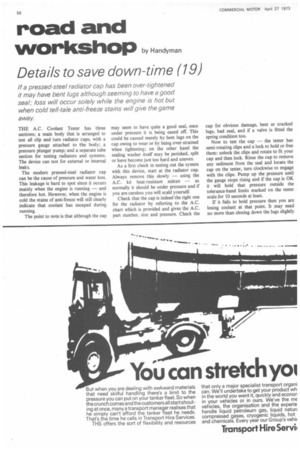road and
Page 60

Page 61

If you've noticed an error in this article please click here to report it so we can fix it.
workshop by Handyman
Details to save down-time (19)
If a pressed-steel radiator cap has been over-tightened it may have bent lugs although seeming to have a good seal; loss will occur solely while the engine is hot but when cold tell-tale anti-freeze stains will give the game away.
THE A.C. Coolant Tester has three sections; a main body that is arranged to test all clip and turn radiator caps, with a pressure gauge attached to the body; a pressure plunger pump; and a separate tube section for testing radiators and systems. The device can test for external or internal leaks.
The modern pressed-steel radiator cap can be the cause of pressure and water loss. This leakage is hard to spot since it occurs mainly when the engine is running — and therefore hot. However, when the engine is cold the stains of anti-freeze will still clearly indicate that coolant has escaped during running.
The point to note is that although the cap may seem to have quite a good seal, once under pressure it is being eased off. This could be caused merely by bent lugs on the cap owing to wear or by being over-strained when tightening; on the other hand the sealing washer itself may be perished, split or have become just too hard and uneven.
As a first check in testing out the system with this device, start at the radiator cap. Always remove this slowly — using the A.C. kit heat-resistant mitten — as normally it should be under pressure and if you are careless you will scald yourself.
Check that the cap is indeed the right one for the radiator by referring to the A.C. chart which is provided and gives the A.C. part number, size and pressure. Check the cap for obvious damage, bent or cracked lugs, bad seal, and if a valve is fitted the spring condition too.
Now to test the cap — the tester has semi-rotating clips and a lock to hold or free them: unlock the clips and rotate to fit your cap and then lock. Rinse the cap to remove any sediment from the seal and locate the cap on the tester, turn clockwise to engage with the clips. Pump up the pressure until the gauge stops rising and if the cap is OK it will hold that pressure outside the tolerance-band limits marked on the tester • scale for 10 seconds at least.
If it fails to hold pressure then you are losing coolant at that point. It may need no more than closing down the lugs slightly on the cap to make it hold pressure, but if this fails, or the lugs are too worn, then the cap should be replaced. Occasionally, a new seal can put the cap in order again. When seeking out external or internal leaks, you will need the radiator connector tube. This has an adaptor at each end, one large, one smaller; each is fitted with a cross-bar that sites inside the radiator neck and a seal that screws down to make an airtight joint. The larger one fits the pump in the same way and there is a spacer if needed.
For testing, the engine should be warm from the last operation so that all metals are fully expanded. Again, remove the radiator cap carefully and insert the clamping bar with the tube-thread fully unscrewed, locate the clamp to take hold of the radiator neck inside and screw down the seal firmly on the top of the neck. According to the size of filler neck it may be necessary to reverse the tube and use the other size adaptor.
In order to test the cooling system with the unit now attached, pump up to the pressure that is correct for that system, watch the gauge pointer and if it falls check all hoses, clips and joints for leaks. External leaks will at once be visible, even seepage points will show up and all points can be given a nip-up; any doubtful ones should be changed.
Big problems The big problems are, of course, internal leaks and these are dealt with a little differently. Couple up in the same way, pump up to test pressure and let the engine run at a steady idling speed and watch the gauge point. Fluctuations of the needle usually indicate a leaking head gasket, and you could be lucky in that a nip-up will cure it; it can, of course, mean that the gasket is blown and a replacement is needed, but you have at least found the trouble quickly.
Where there are other internal leaks such as a wet liner seal in trouble, porosity in the water jacket floor and injector seatings leaking, an internal inspection may be needed with the sump removed.
Apply the pressure and the leak will show up, even where it may be passing down a piston past the rings, but you have the area pinpointed and time is saved.












































































































